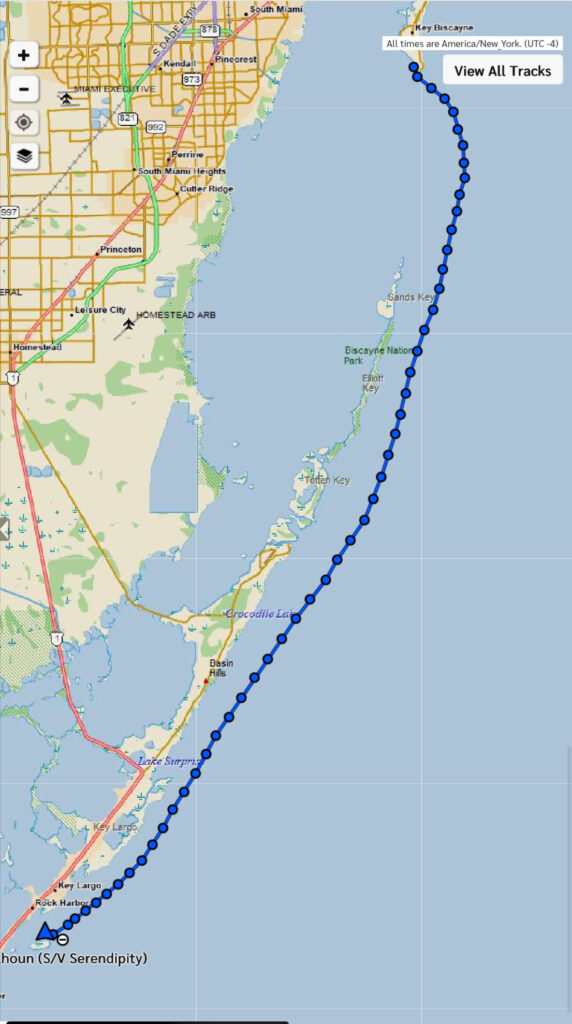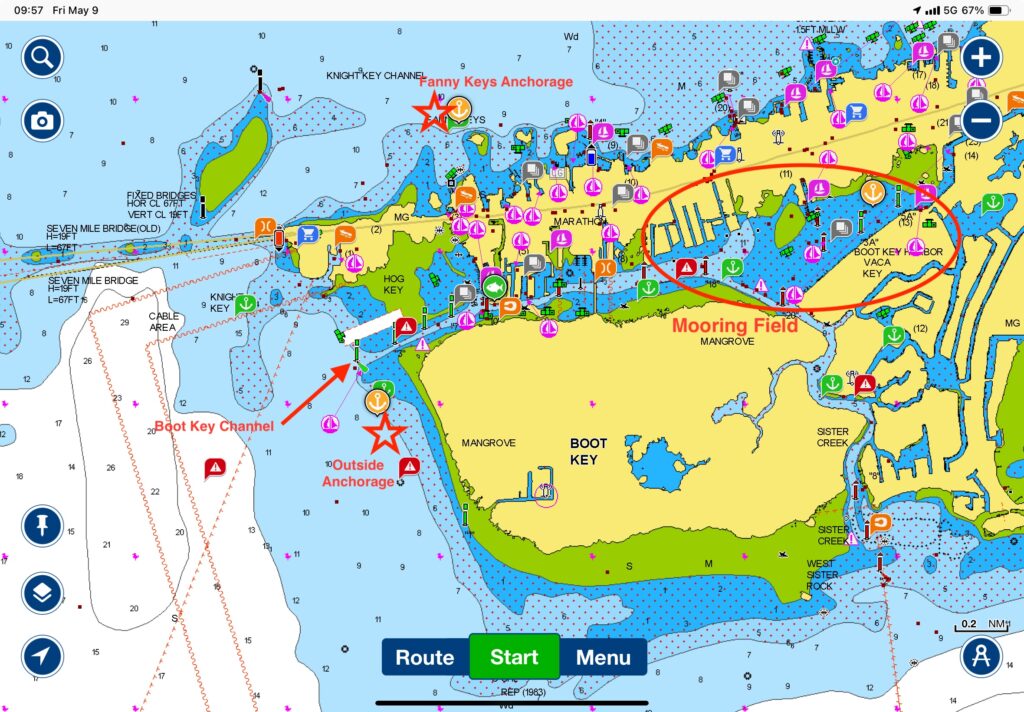Distance: 48 nm/Time: 9 hrs

I weighed anchor at 8 am expecting a lovely and worry-free day of easy sailing to the anchorage at Rodriquez Key. I planned to stay there a night and then proceed to Marathon. Lara and Simon had arrived there in Passages the day before and had immediately gotten a mooring ball. They said that I shouldn’t have a problem as it looked like people were starting to leave to head north or to the Bahamas1. That was good news as there weren’t a lot of anchoring options for me in the Keys, and the support facilities at Boot Key Harbor in Marathon, run by the City Marina, were awesome.
Weighing the anchor was uneventful. It was nice to be back in the land of the sandy (rather than muddy) bottoms where the anchor and chain come up clean. Everything was going swimmingly until I stareted heading out the channel and brought the engine RPMs up to cruise. With great angst and disappointment I watched the engine temp rise past 180, past 185, past 190, past 200 before I decided to throttle back and see at what RPM I could maintain a normal temperature. It turned out to be 1750. That gave me only 4 knots over the ground. WTF!? Just the night before I had motored for 13 hours straight without an issue after flushing the engine, and now it was overheating again, and even worse then before I flushed it? Are you kidding me!? (I hate this engine.) I did a quick check to make sure there were no water leaks or any other external indications. There were none.
So now I had a choice to make: Turn around and go back to the anchorage or continue to Rodriquez Key and thence to Marathon. I figured since the forecast called for favorable sailing conditions today that I’d be able to sail most of the way to Rodriquez and so wouldn’t be using the engine much, anyway. And, there’d probably be more support for me in Marathon than in Miami (or at least less expensive). And at this point, my frustration level with this engine had peaked–inversely to my trust in it–and quite frankly, I thought that just getting it to a mooring ball in Marathon and putting the damned boat up for sale wasn’t out of the question. Of course, first I would remove the clam shell strainer on the outside of the raw water intake to see if the through hull was clogged. Hopefully, that was the issue since that would be a simple fix. If not that, then perhaps the thermostat had failed, with would be a medium-sized fix. Either way, they were the next things to try.
So, I puttered out of the channel, turned south, waiting for the wind to build enough, then hoisted the sails and turned off the engine.
Needless to say, it was not an enjoyable day with the engine and the future of my cruising capabilities on my mind. I was only able to get around 5 knots sailing, and by the time I got within 6 miles of Rodriquez Key, the winds had died, requiring me to start the engine and motor at 4 knots the last hour and a half. The engine was still overheating at anything over 1700 RPM.
I had anchored easily at Rodriquez Key when I passed through last May, but had a slightly more difficult time today. Because of where the other boats were anchored, I had to find a different area than last year–one with a lot more sea grass. I found that if I didn’t hit a sandy patch when dropping the anchor, i.e., it landed in a sea grass patch, it wouldn’t set. It took me two tries before I figured out which angle from the sun would best allow me to differentiate between the two types of bottom and once I hit sand, the anchor set well. It was 5 pm.
I had not been sitting idle when sailing, but was trying to anticipate what I would need to do tomorrow. I had talked with Simon and Lara about their experience with getting a ball, and had also called up the City Marina in Marathon to ask about availability. They said they didn’t have any balls open right then, but expected to have some over the next couple of weeks as people left. They told me to call tomorrow to get an update. Oh, and if there wasn’t a ball open, but I wanted to be put on the mooring ball waiting list, I had to show up in person in their office and pay for a dinghy pass for at least a week to get put on the list. (I guess they don’t want people calling in from North Carolina or something, clogging up the list.)
This presented many difficulties for me, exacerbated by the weather forecast. It called for quite strong winds out of the southeast for the next few days, followed by a strong cold front (which causes the wind to veer to the NW when it passes.) This forecast meant that remaining in Rodriquez Key would not be a good option as it wasn’t very well protected from the southeast. So, I would need to move on, as planned.

However, if I arrived in Marathon and there was not a ball available, the popular anchorage right outside the harbor entrance was also exposed to winds from the southeast, so it was not a good option for tomorrow night, either. In fact, if I couldn’t get a ball in the fully-protected mooring field in the harbor, the only viable option anywhere close to Marathon looked to be an anchorage called Fanny Keys north of Vaca Key (the island that Marathon was on).
So, here was the problem. To get on the mooring ball waiting list, I had to show up in person. But, how to do that? If I anchored outside the harbor, it was almost two miles into the marina office, and since my dinghy was stowed, that meant 4 miles out and back on the paddleboard. That wasn’t going to happen. I am not in shape enough for even two miles. I could deploy the dinghy, but that would take two hours and by the time I did that, the marina office would surely be closed. So, I would have to anchor in Fanny Keys, which meant another hour to go through the Seven Mile Bridge and back around to the north side of the island, but then I’d still have to get ashore and walk a mile and a half to the marina office before they closed. And, with the cold front coming in two days, if I ended up in Fanny Keys, I’d have to move again to a different anchorage before the front, and anchorages protected from the northwest were even further away from Boot Key Harbor.
The City Marina also had another rule: If they had a ball available when you called, they would let you know that, but as it was first come/first served, they wouldn’t assign you the ball until you called them on the radio when passing under the bridge at the entrance to the mooring field (a mile inside the harbor entrance). So, I needed to be able to get to that point by 5:30 pm, which meant getting to the channel entrance by 5 pm at the latest. Forty-six nautical miles divided by 4.5 knots yields 10 hours of transit time. 5 pm less 10 hours is a 7 am departure. I wasn’t sure if there was any northwest current in Hawks Channel, so decided to give myself an extra hour to play with, so planned to depart in the dark at 6 am in the morning. Hopefully, the engine overheating hadn’t gotten worse yet again.
- It seems that I’ve always been going counter to the migration flow for the last year. I got a late start and by the time I finally made it up to the Chesapeake in late September, everyone else was already starting to head back south. Now that I finally made it south, everyone was heading back north! “Hey! Wait for me!!!!” ↩︎